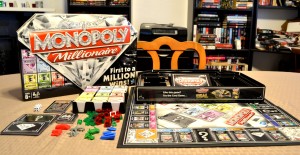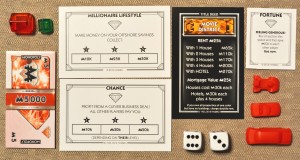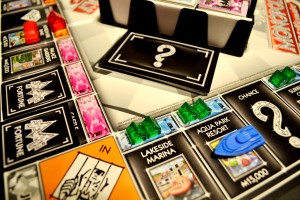“Monopoly Empire” wasn’t the best thing to have ever crossed my path, but it was good enough of a “Monopoly” spinoff to receive a thumbs-up from the kids. “Monopoly Millionaire” is the next spinoff that I chose to pick up on a whim and luckily, it was on sale for fifteen bucks (down from the normal twenty to thirty dollars) at my local K-Mart. Instead of trying to build a tower however, players will be racing to reach a net worth (cash-wise) of one million before the others do. How does it stand up to the other “Monopoly” variants on the market, you ask? Keep reading to find out!
Components
Board – The game includes a standard “Monopoly” board, though there are only eight spaces going across the perimeter on each side (instead of ten).
Movers – These serve as the pieces that players will be moving around the board. Each of the four colored sets have three distinct pieces, each representing a different lifestyle level.
Cash – These cardboard money tiles come in various denominations. Players will be earning and spending these throughout the game.
Title Deeds – These help players keep track of who owns what property, just like in regular “Monopoly”.
Chance & Millionaire Lifestyle Cards – These are your standard Chance and Community Chest cards, respectively. Players will be able to pick these up when they land on the appropriate space.
Fortune Cards – These cards act like Chance and Millionaire Lifestyle cards, but are instead placed on the property spaces for players to collect as they land on them.
Houses, Hotels, & Dice – Houses and hotels serve to increase the value of a property, while dice are used for movement.
Setup & Gameplay
The bank of money tiles is placed in the center of the board, with the Chance and Millionaire Lifestyle cards being shuffled separately and placed onto their appropriate spaces nearby. The Fortune cards are shuffled, with one being placed facedown on each of the property spaces. Each player chooses a mover set of one color and takes 372k for their starting money. The lowest valued mover in a set (1 star) is placed on GO.
Rather than explain the intricacies of “Monopoly”, I’ll simply opt to hi-lite the relevant details that separate this spinoff from the core game:
1. When passing GO, you’ll collect one of three salaries. The amount depends on the lifestyle mover you currently own. A one-star mover pays 150k, a three-star mover pays 200k, and a five-star mover pays 250k. Every time you pass GO, you can opt to upgrade your mover by subtracting 50k from your normal GO earnings.
2. When a player lands on a property space that hasn’t been claimed, it MUST be bought or auctioned off. In addition, the player will take the Fortune card, if present, and follow the instructions.
3. Some cards will have three different outcomes, depending on the player’s current lifestyle mover. The higher the lifestyle, the more lucrative the rewards.
4. Players can make deals and build real estate on their turn at will. Opponents who land on a player owned property pay rent as normal. If the owner has the entire set but has no houses on that set, the rent is doubled. Houses and hotels must be built evenly among all of the properties in a set…meaning you can’t have one property in a set with a single house and another with a hotel. Houses and hotels can only be built if a player owns the entire set.
5. Players can mortgage properties and sell real estate if they find themselves bankrupt.
The first player to reach one million in cash, wins the game!
The above doesn’t cover all of the rules found in the manual, but should help give you an idea as to how this particular version of “Monopoly” plays out. For more information, see the links at the end of this article.
The Review
I must say, I was extremely disappointed with the components. They’re cheap, flimsy, and clearly designed to save money during the manufacturing process. The Chance and Millionaire Lifestyle cards don’t even have any color to them…it’s just black text on a white background. The mover pieces are plastic instead of metal, and the Fortune cards may as well have been made out of parchment paper. The money wasn’t made of paper, but cardboard tiles…I’m not sure what the developers were going for. For as luxurious as this game attempts to make players, it does a really crappy job immersing the player in the role. If I were to look up irony in the dictionary, I’d find a picture of this game right beside the definition. Seriously guys, try harder…
In the gameplay department, the game misses some obvious strategic avenues…at least they are obvious to me. At present, there is no reason NOT to upgrade your mover. The faster you upgrade your mover, the faster you’ll reach the million. There’s no penalty for being more luxurious or for holding onto a particular tier of lifestyle. Like with “Monopoly Empire”, the rich tend to get richer at an exponential rate without penalty. It wouldn’t have been that hard to include tax cards within the two decks to penalize those on the richer tiers of lifestyle…yet the game barely touches on that. There’s a Chance card or two that knocks the player down a lifestyle tier, but there’s simply not enough of those types of cards in these decks to make a difference.
The kids and I played a four player game that lasted roughly ninety minutes. It didn’t take us long to level up to the highest lifestyle mover piece. Once there, it was just a matter of who passed GO the most, as you earn 250k each time. The properties, when upgraded with a few houses, only rewarded the owner a little over 100k when someone else paid rent for them. It seemed more cost-efficient to simply save your money and pass GO as opposed to investing in your properties. The rent values, even with houses, didn’t pay out enough to really make up for the investment…not to mention that there was no guarantee that folks would land on your properties in the first place. While I was tempted to amass some expensive real estate, I simply held onto my money and opted to lap the board as quickly as possible…it paid off and I ended up winning the game.
In conclusion, “Monopoly Millionaire” is all flash and no substance, and even some of the flash can be called to question. At best, it would appeal to casual gamer families who just want to roll dice and move pieces around a board…a lifestyle that I’m not knocking, mind you. There are MANY nights were I prefer the simpler games, especially when the day’s number crunching duties haven’t been kind to me. With that being said, I’d be hard pressed to recommend this even to casual gamer families as there are other games on the market that observe a higher level of quality. My advice is to avoid “Monopoly Millionaire” like the plague, if you know what’s good for you. A few of the components do look pretty, but beyond that, there’s really no reason to get invested in this particular “Monopoly” variant.
Final Verdict: 3/10
—
You can learn more about and purchase “Monopoly Millionaire” by visiting the following websites:
http://www.hasbro.com/monopoly/en_US/shop/details.cfm?R=0FA49F3D-5056-900B-10CA-C90C503C6495:en_US
—



